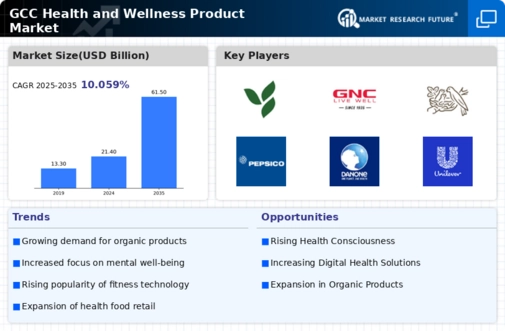Rising Health Consciousness
The Global GCC Health and Wellness Product Market Industry is experiencing a notable surge in consumer awareness regarding health and wellness. This trend is largely driven by an increasing understanding of the benefits of preventive healthcare and a shift towards healthier lifestyles. As individuals become more informed about nutrition and fitness, the demand for health products, including organic foods and dietary supplements, escalates. This heightened consciousness is reflected in the market's projected value of 235.94 USD Billion in 2024, indicating a robust growth trajectory as consumers prioritize their well-being.
Aging Population and Chronic Diseases
The demographic shift towards an aging population in the GCC region is significantly influencing the Global GCC Health and Wellness Product Market Industry. As the population ages, there is a corresponding increase in the prevalence of chronic diseases, which drives demand for health products aimed at disease prevention and management. This trend is prompting healthcare providers and product manufacturers to focus on solutions tailored to older adults, such as dietary supplements and wellness programs. The market is expected to grow substantially, with projections indicating a value of 541.32 USD Billion by 2035, driven by the need for effective health management solutions.
Government Initiatives and Regulations
Government policies and initiatives play a crucial role in shaping the Global GCC Health and Wellness Product Market Industry. Various GCC nations are implementing regulations aimed at promoting health and wellness, such as stricter food safety standards and incentives for healthy product development. These initiatives not only enhance consumer trust but also encourage manufacturers to innovate and diversify their product offerings. For instance, the introduction of health awareness campaigns and subsidies for organic farming is likely to bolster market growth, contributing to the anticipated market expansion to 541.32 USD Billion by 2035.
Technological Advancements in Health Products
Technological innovation is a driving force in the Global GCC Health and Wellness Product Market Industry. The integration of advanced technologies in product development, such as artificial intelligence and biotechnology, is enabling the creation of more effective and personalized health solutions. For example, the rise of wearable health devices and mobile health applications is transforming how consumers monitor their health and wellness. This trend is expected to attract a tech-savvy demographic, further propelling market growth. As a result, the industry is poised for a compound annual growth rate of 7.84% from 2025 to 2035.
Growing Demand for Natural and Organic Products
There is an increasing consumer preference for natural and organic products within the Global GCC Health and Wellness Product Market Industry. This shift is driven by a desire for cleaner labels and a growing skepticism towards synthetic ingredients. Consumers are actively seeking products that align with their values of sustainability and health. This trend is evident in the rising sales of organic food and natural supplements, which are projected to significantly contribute to the market's growth. The industry's expansion is underscored by the anticipated market value of 235.94 USD Billion in 2024, reflecting a robust demand for organic offerings.





















Leave a Comment